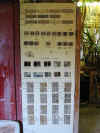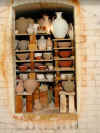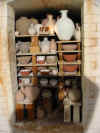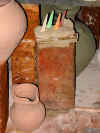|
Before starting the firing process it is essential to actually make something
to put in the kiln. Fortunately, the Reporting Team were able to infiltrate the
pottery and find some instructions:-
|

|
Aha, the totem pole of all knowledge. DIY and home
furnishing stores regularly send spies to try and steal this! |
|

|
Chapter 1 - Different clay types showing the amount of
shrinkage that normally occurs. |
|

|
Chapter 2 - These are examples of various glaze materials. |
|

|
Chapter 3 - Like the legend says, the end result usually
achieved with the different glaze types. |
|

|
Chapter 4 - These are examples of various ash glaze
tests. |
|

|
Finally, the cooking instructions. Actually, Trevor keeps a
temperature log of each firing so that he can note where variations
produce different results. Yup, folks, part of the beauty of this work is
that you can never be 100% sure what will come out of the kiln. |
Ok, team, get those wheels spinning and sling some pots.
What do you mean, your legs aren't long enough? OK, then, here's some
plasticine, see what you can do with that.
And hurry up, Trev will be back in five minutes ...
|

|
And here we have the result of the Reporting Team's
handiwork. Well, actually the result of four weeks labour at the pottery.
It takes days just to stack the thing.
[Note colour, or relative lack of it and prepare to be dazzled] |
|

|
The kiln looks like it ought to be in Fort Knox!. The white
stuff that looks like polystyrene is the insulation and is remarkably
effective. You can (with permission and supervision obviously) actually
put your hand on the outside of the kiln even when it's cranked up to over
1200 degrees centigrade inside. |
|

|
There's always some idiot who ruins a perfectly good shot! |
|

|
Despite his years of experience not all of Trev's ideas come
off. Here his attempt at creating an energy-saving candle powered kiln
proved less than entirely successful ... |
|

|
... nor did his attempt to create a stegosaurus. Master
potter he may be but Ray Harryhausen he ain't! [Actually they are pyrometric cones that react at different
temperatures and are, thus, used as a visual check on what the kiln is up
to on the inside.] |
Next Back
Home
|
